Microsoft Surface Pro 3 Review
by Anand Lal Shimpi on June 23, 2014 3:55 AM ESTBattery Life
Microsoft made no sacrifice in battery capacity in pursuit of Surface Pro 3's thin chassis design. The new tablet features an integrated 42Wh battery just like the previous two models. Charging duties are handled by an external 31W charger with a brand new magnetic connector. Microsoft never seemed to get a good MagSafe clone working in the previous models, so Surface Pro 3 abandons the previous design entirely in favor of something a bit more sensible.
The new connector no longer looks like an oversized MagSafe connector, and instead features a thin plastic insert that mates with the charge port on Surface Pro 3. Charge time hasn't changed, you can fully charge the device in around 2.62 hours:
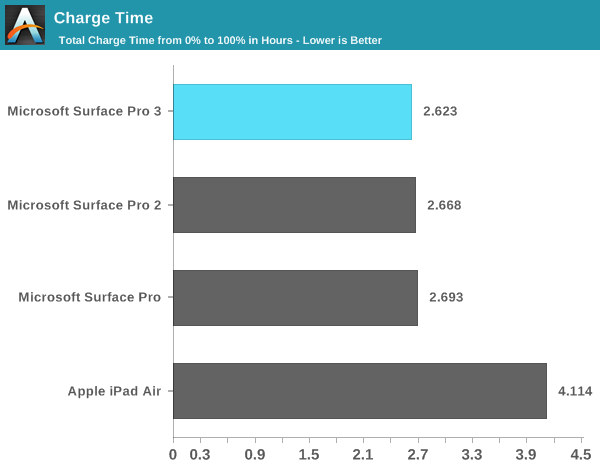
The device-side connector features 40 pins but you only need 12 of them to charge the device. The remaining pins are used for Gigabit Ethernet, USB, DisplayPort (up to 4096 x 2304) and audio. Microsoft seems hell bent on avoiding Thunderbolt at all costs so instead of embracing the standard it has created a custom alternative of its own doing. The benefit to Microsoft's connector is it can obviously deliver more power than Thunderbolt can, the downside is that it can't send PCIe and thus you don't get support for any ultra high bandwidth external storage devices. I still would rather see Microsoft implement Thunderbolt as there's at least an existing ecosystem built around that but here we are three generations into Surface and if we haven't seen it by now I don't think we're ever going to.
The supplied power adapter includes a USB charge port capable of delivering 1A at 5V.
As Surface Pro 3 is designed to be both a laptop and a tablet I've run it through both our Windows laptop battery life tests and our tablet battery life tests.
Laptop Battery Life
As a laptop, Surface Pro 3 delivers comparable battery life to other optimized Haswell ULT designs. I threw in Sony's Vaio Pro 13 into the mix because it has a similar sized battery (37Wh vs. 42Wh) and is one of the most power efficient Windows Ultrabook platforms on the market. Surface Pro 3 manages to deliver similar battery life, which means it's a little less power efficient but the two are within the same range at least.
Compared to Surface Pro 1 and 2, Surface Pro 3 at worst delivers similar battery life and at best increases range on a single charge by up to 20%. We're looking at 3.75 hours - 7.6 hours of notebook usage on a single charge depending on usage.
It's worth noting that there's a substantial advantage in battery life if we look at the 13-inch MacBook Air running OS X. I only mention this because of Microsoft's insistence on comparing Surface Pro 3 to Apple's popular line of notebooks.
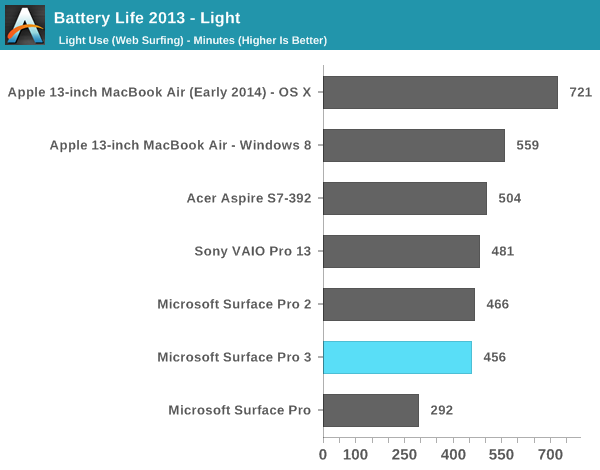

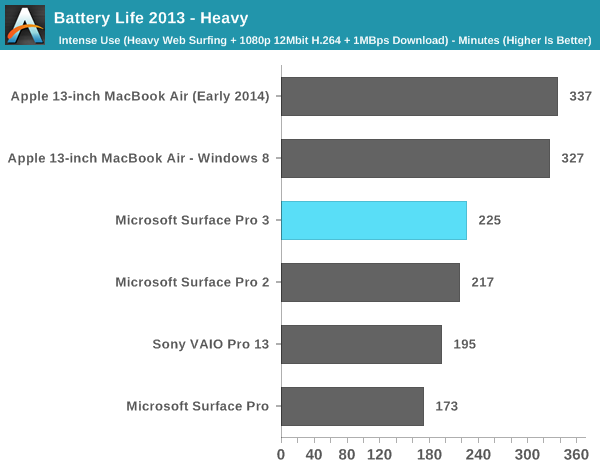
Tablet Battery Life
Tablet workloads are going to be far more display power bound than anything else. Here we see 7.58 - 8.03 hours of continuous usage, a slight regression compared to Surface Pro 2. Video playback remains more power hungry than web browsing, which is something I've noted in previous tablet-evaluations of Intel's Core silicon. I don't believe Intel's Core processors are very optimized for video decode power consumption. If anything is going to change with the move to Broadwell and Core M I suspect video decode power may be it.
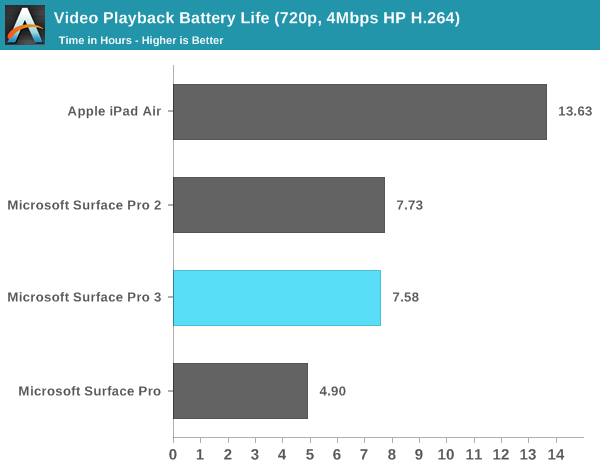
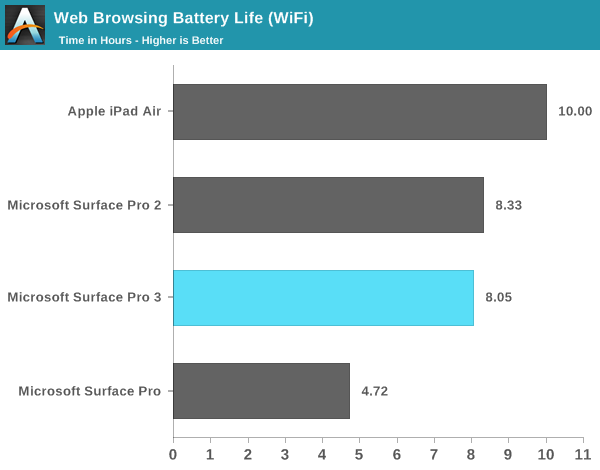


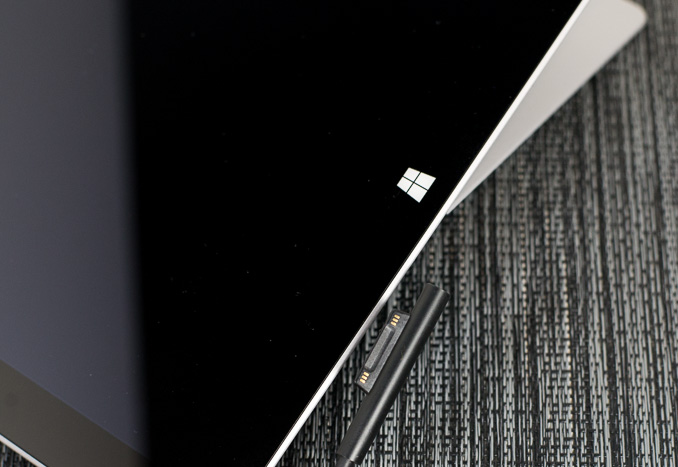
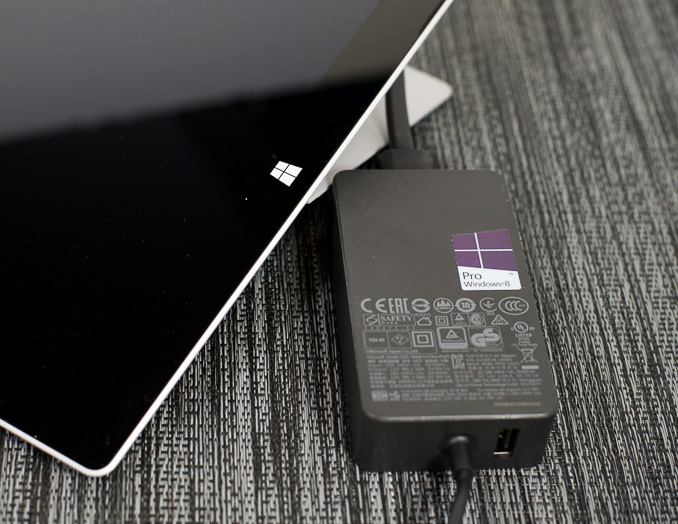








274 Comments
View All Comments
jeffkibuule - Monday, June 23, 2014 - link
30% lower power consumption, 30-40% increase in GPU performance.Morawka - Tuesday, June 24, 2014 - link
It will have either or, not both. It will either use 30% less power at the same performance (GPU included) or use the same power with a 30% increase in performance. You cant have both unless there is a new architecture, and broadwell is simply a haswell shrink.Sure they can take the power savings and add more GPU EU's but that's gonna negate the power savings.
Laxaa - Tuesday, June 24, 2014 - link
Skylake is after Broadwell, right? Maybe wait for that one?I am lookin into buying a new laptop next year, and as a graphic designer, the Surface Pro 3 looks appealing because of the pen. CPU performance seems fine for my needs, but I want lower power consumption and a better GPU(If I had to choose I'd take a better GPU) The size looks fine, and I'm not sure if I'd like it to be tinner. 9.1 mm is still pretty thin.
mkozakewich - Monday, June 30, 2014 - link
I've found that putting everything on low-power mode is still usable, but gives me an extra hour or two of battery life (on the original Surface Pro, even). Everything should be fluid enough for you with the latest one.Just make sure that issue with the edges of the screen is gone, with the move to NTrig.
Krysto - Monday, June 23, 2014 - link
Not the best laptop, not the best tablet. I think that pretty much sums up Surface in general. It's an all-compromise device.eddman - Monday, June 23, 2014 - link
You lug your laptop AND tablet around while those who are tired of it or don't have the means to do so, take an SP3.Is it really that hard to see what and who a surface pro is meant for?
name99 - Tuesday, June 24, 2014 - link
This argument only works if you're frequently in the position of having to carry both.A far more common situation is, for example, you take your laptop to school/work and use it to do laptoppy things well, an you use your table at home to do tabletty things well.
Sure if you are, for example, a journalist or traveling salesman you may be in the position of wanting to carry tablet and laptop functionality with you, and S Pro may make sense. But I think the journalist point of view (for obvious reasons) gets rather more attention on the internet than is warranted by the relevant fraction of people with these sorts of requirements.
PaulC543 - Tuesday, June 24, 2014 - link
No, the argument doesn't -only- work as you outlined, there's any number of reasons one might prefer a single device.I don't travel much, but when I do, I need a system capable of making revisions to work if need be. I have no need for the amount of text entry that would make a traditional laptop more attractive, so a tablet that could run my desktop programs was ideal. I can use it around the house for tabletty things, dock it and use it for real work, and take it when traveling to do both tabletty and work tasks.
People really need to accept that there are other use scenarios than their own. It really seems to be a mental block for the people who don't get the value of the Surface. I'm not saying the audience who do get the Surface is huge, it's clearly not, but it seems to be big enough to support Microsoft's continued development of the device, and that's all that really matters.
I don't comment on and criticize server products, because I have neither the knowledge, need or interest in the hardware that serves the market. I really wish people who don't have the knowledge, need or interest in the market the Surface serves would kindly refrain from criticizing since it's almost entirely baseless and/or misplaced.
gken8 - Tuesday, July 1, 2014 - link
let me shed light on this, the legal profession loves this tablet.ymcpa - Tuesday, June 24, 2014 - link
There is also the position where you might carry only one device but frequently find that you wish you had another device with you. For example, you might be using a laptop for work but when you go on a break, you wish you had a tablet with you to do some browsing or to watch a video. Or you are on vacation with your tablet but you get a call from work asking for some info and you wish you had your laptop with you.